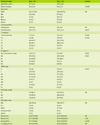Abstract
Purpose
Breast carcinoma in young patients has been reported to present with more aggressive biologic characteristics and to behave poorer compared with the disease in older patients. However, the association between the age and the prognosis in premenopausal patients has rarely been reported on. This study aimed to reveal the clinicopathologic characteristics and prognostic significance of young age (age≤35) for the breast cancer of premenopausal women.
Methods
We retrospectively analyzed 1033 premenopausal women with breast cancer who underwent surgery in our institution between 1985 and 2003. A total of 180 patients were aged >35 years (the younger premenopausal group) and 853 patients were aged >35 years (the older premenopausal group). The clinicopathologic characteristics and treatment outcomes were compared between the younger and older groups.
Results
Compared to the older premenopausal group, the younger group showed earlier menarche (15.2±19 years old versus 16.0±1.7 years old, respectively, p<0.001), larger tumor (3.7±2.1cm versus 3.2±2.0cm, respectively, p=0.002), more metastatic axillary lymph nodes (3.8±7.0 versus 2.4±5.7, respectively, p=0.001), more advanced TNM stage (p=0.015), a lower PR positive rate (47.7% versus 59.9%, respectively, p=0.011), and a higher P53 positive rate (71.7% versus 54.9%, respectively, p=0.034). The recurrence rate for the younger group was 26% as compared with 14.4% for the older group. The overall 5-year and 10-year survival rates of younger group were 79.3% and 68.5%, respectively and these of older group were 91.1% and 84.3%, respectively.
Conclusion
In premenopausal women with breast cancer, patients with an age≤35 years have a greater chance of having an endocrine non-responsive tumor, and they are more likely present with larger tumor, more metastatic axillary lymph nodes and a more advanced TMN stage. These results show that younger premenopausal patients have a worse prognosis than older premenopausal patients.
References
1. Annual report of central cancer registry in Korea 2002.1.-2002.12. 2005. Gwacheon, Korea: Ministry of health and welfare.
2. The Korean Breast Cancer Society. Nationwide Korea Breast Cancer Data of 2002. J Breast Cancer Soc. 2004. 7:72–83.
3. de la Rochefordiere A, Asselain B, Campana F, Scholl SM, Fenton J, Vilcoq JR, et al. Age as prognostic factor in premenopausal breast carcinoma. Lancet. 1993. 341:1039–1043.

4. Dubsky PC, Gnant MF, Taucher S, Roka S, Kandioler D, Pichler-Gebhard B, et al. Young age as an independent adverse prognostic factor in premenopausal patients with breast cancer. Clin Breast Cancer. 2002. 3:65–72.

5. Sariego J, Zrada S, Byrd M, Matsumoto T. Breast cancer in young patients. Am J Surgery. 1995. 170:243–245.

6. Kim SW, Kim HJ, Chung KW, Noh DY, Youn YK, Oh SK, et al. The investigation of an age as a prognostic factor of breast cancer. J Korean Surg Soc. 2003. 64:20–27.
7. The Korean Breast Cancer Society. The breast. 2005. 2th ed. Seoul: Ilchokak.
8. Gonzalez-Angulo AM, Broglio K, Kau SW, Eralp Y, Erlichman J, Valero V, et al. Women age≤years with primary breast carcinoma: disease features at presentation. Cancer. 2005. 103:2466–2472.
9. Walker RA, Lees E, Webb MB, Dearing SJ. Breast carcinomas occurring in young women (<35years) are different. Br J Cancer. 1996. 74:1796–1800.

10. Colleoni M, Rotmensz N, Robertson C, Orlando L, Viale G, Renne G, et al. Very young women with operable breast cancer: features of disease at presentation. Ann oncol. 2002. 13:273–279.

11. Jung JH, Park HY, Lee YH. Clinical value of CEA, CA15-3 and TPS in breast cancer. J Korean Surg Soc. 2001. 60:584–591.

12. Buamah PK, Bent DJ, Bodger WA, Skillen AW. A Profile of serum CA 15-3, CEA, ALP, and gamma glutamyl transferase levels in patients with breast cancer. J Surg Oncol. 1993. 53:84–87.

13. Kim JS, Noh DY, Yoon YJ, Oh SK, Choe KJ. Analysis of postoperative survival and prognostic factors in breast cancer. J Korean Surg Soc. 1998. 54:640–648.
14. Shim KS, Park CS, Min JS, Lee KS. A study on prognostic factors influencing treatment results in breast cancer patients. J Korean Surg Soc. 1991. 40:716–723.
15. Fisher ER, Gregorio RM, Fisher B, Redmond C, Vellios F, Sommers SC. The pathology of invasive breast cancer. A syllabus derived from finding of the National Surgical Adjuvant Breast Project. Cancer. 1975. 36:1–85.

16. Yildirim E, Dalgic T, Berberoglu U. Prognostic significance of young age in breast cancer. J Surg Oncol. 2000. 74:267–272.

18. de la Rochefordiere A, Asselain B, Campana F, Scholl SM, Fenton J, Vilcoq JR, et al. Age as prognostic factor in premenopausal breast carcinoma. Lancet. 1993. 341:1039–1043.

19. Crowe DR, Conner MG, Weiss HL, Sellers MT, Krontiras H, Urist MM, et al. Molecular biomarkers for breast cancer prognosis: coexpression of c-erbB-2 and p53. Ann Surg. 2001. 233:630–638.

20. Valagussa P, Bonadonna G, Veronesi U. Patterns of relapse and survival following radical mastectomy. Cancer. 1978. 41:1170–1178.

21. Crowe JP Jr, Gordon NH, Antunez AR, Shenk RR, Hubay CA, Shuck JM. Local regional breast cancer recurrence following mastectomy. Arch Surg. 1991. Apr. 126:429–432.

22. Feldman AL, Welch JP. Long-term outcome in women less than 30 years of age with breast cancer. J Surg Oncol. 1998. 68:193–198.





 PDF
PDF ePub
ePub Citation
Citation Print
Print








 XML Download
XML Download